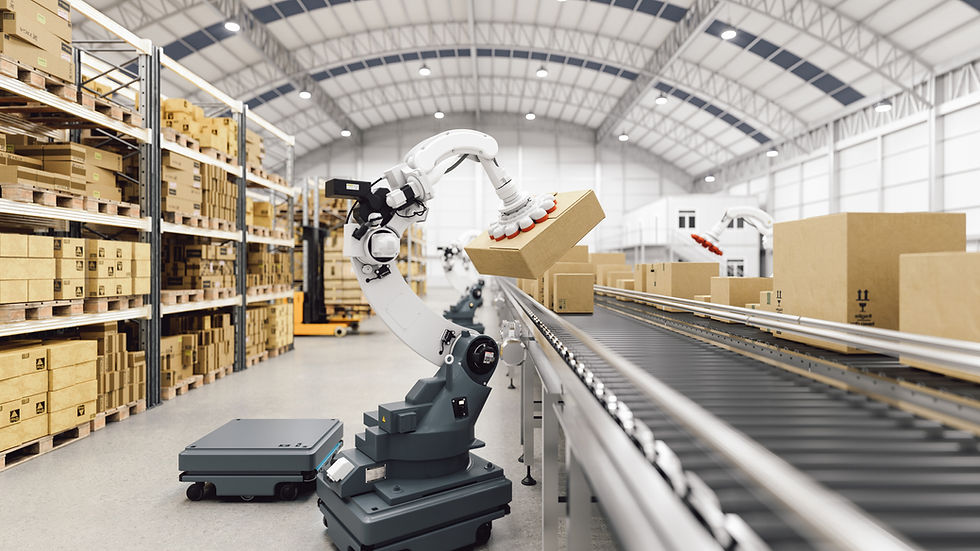The Evolution Unveiled: The Rise of Warehouse & Logistics Automation in Modern Supply Chains
- John Stikes

- Jan 13, 2024
- 3 min read
Updated: Apr 7

Introduction:
In the fast-paced realm of logistics and supply chain management, where efficiency and precision are paramount, the rise of warehouse and logistics automation has been nothing short of revolutionary. From advanced robotics to intelligent software systems, warehouses are undergoing a transformative shift. In this blog post, we will explore the burgeoning trend of warehouse automation, uncovering the reasons behind its rise, and examining the transformative impact it has on modern supply chains, with real-world examples of companies at the forefront of this revolution in automation.
The Need for Speed and Efficiency: Modern consumers expect swift and accurate order fulfillment, prompting companies to seek ways to enhance their warehouse operations. The rise of e-commerce and the demand for quick deliveries have necessitated a paradigm shift in warehouse management. Automation, with its ability to streamline processes and eliminate bottlenecks, emerges as the solution to meet these heightened expectations.
Advanced Robotics Taking Center Stage:
One of the most visible aspects of warehouse automation is the deployment of advanced robotics. These robotic systems are designed to perform a myriad of tasks, from picking and packing to sorting and transporting goods within the warehouse. The precision and speed of robotic operations significantly reduce the time required to fulfill orders, leading to improved overall efficiency. Leading the charge in this robotic revolution is Amazon, with its Kiva robots navigating warehouses autonomously. These robots bring shelves of products to human workers for packing. Similarly, companies like Ocado, a UK-based online grocery retailer, have implemented highly automated warehouses where robots work collaboratively with human staff to fulfill orders efficiently.
Integration of Artificial Intelligence (AI):
Warehouse automation goes beyond physical robots; it also involves the integration of artificial intelligence (AI) into various aspects of supply chain management. AI algorithms analyze vast amounts of data to optimize inventory management, predict demand patterns, and enhance overall decision-making processes. This level of intelligence allows warehouses to operate with unprecedented efficiency and accuracy. Alibaba, a global e-commerce giant, utilizes AI-driven warehouse automation to manage its extensive inventory and logistics networks. By leveraging AI for predictive analytics and demand forecasting, Alibaba optimizes stock levels, reduces waste, and ensures timely restocking, ultimately providing a seamless shopping experience for customers.
The Role of Autonomous Vehicles: Autonomous vehicles, including drones and self-driving delivery trucks, are becoming integral components of warehouse automation. Drones are used for inventory tracking, monitoring, and even order delivery in some cases. Self-driving trucks are being employed for the transportation of goods, reducing reliance on human drivers and increasing the speed of shipments. DHL, a leading logistics company, has been at the forefront of adopting autonomous vehicles. They have successfully implemented autonomous robots in their warehouses for tasks such as order picking and inventory management. Additionally, companies like UPS have been experimenting with drones for last-mile delivery, showcasing the potential of autonomous technologies in transforming logistics.
Scalability and Adaptability: Warehouse automation offers scalability and adaptability, allowing companies to adjust their operations according to fluctuations in demand. During peak seasons or sudden surges in orders, automated systems can scale up to handle increased workloads seamlessly. Conversely, during slower periods, these systems can scale down to optimize energy usage and reduce operational costs. Walmart, a global retail giant, leverages the scalability of warehouse automation to meet the demands of seasonal peaks, such as Black Friday and holiday shopping events. The ability to swiftly adapt to changing circumstances positions Walmart for sustained success in a dynamic market.
Conclusion:
The rise of warehouse automation represents a transformative chapter in the evolution of supply chain management. From advanced robotics to AI-driven decision-making processes, companies across industries are redefining the way they manage and operate their warehouses. The success stories of Amazon, Ocado, Alibaba, DHL, and Walmart underscore the significant benefits that warehouse automation brings to the table – increased speed, enhanced efficiency, and adaptability to changing market dynamics. As technology continues to advance, the trajectory of warehouse automation promises to shape the future of supply chains, offering a blueprint for businesses seeking to thrive in the era of rapid innovation.



